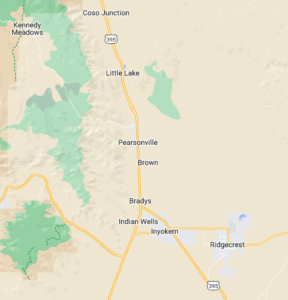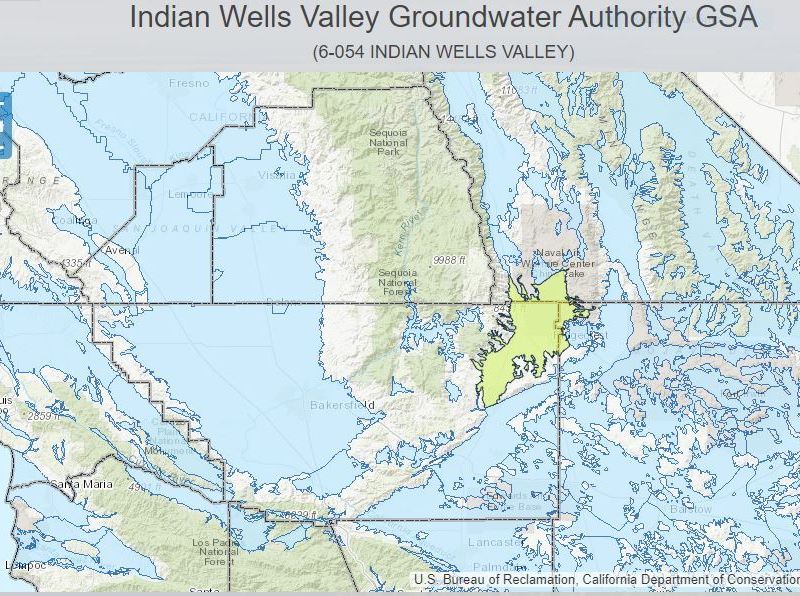Meeting: Indian Wells Valley Groundwater Authority board of directors
Date: May 15, 2024
Agenda and Packet: CLICK HERE
First topic: Reassessment of importing water from Little Lake, an area north of the Indian Wells Valley in Inyo County.
Background: The Indian Wells Valley is a critically overdrafted basin in eastern Kern County. Its residents and businesses require 28,000 acre feet a year while the basin only receives 7,650 acre feet a year in natural recharge.
The groundwater authority intends to buy water from the Palmdale area and build a pipeline to bring it north to the valley. The authority agreed, however, to reassess bringing water south from another desert region called Little Lake, which is in Inyo County. 
Report: Michael McKinney of Capitol Core, a government relations firm that specializes in water and land use issues, concluded the Little Lake plan, which had first been assessed in 2019, was “not feasible” for a number of reasons.
- Inyo County authorities would likely never approve an out-of-county transfer of native water.
- The purchase would only bring in 2,400 acre feet a year. Indian Wells Valley needs to import between 3,000 to 3,500 acre feet a year.
- Taking surface water out of the Little Lake area could reduce groundwater that already naturally flows from that area into Indian Wells Valley.
- Building a conveyance to get the water into and through the Los Angeles Aqueduct down to Indian Wells Valley would require a 3-to-1 water leave behind, reducing the already short supply, and would not be covered by grant funding.
McKinney’s report was called “horseshit” by board member Chuck Griffin, who represents the Indian Wells Valley Water District on the authority.
“I found it very disheartening to read this report, which I, personally, feel is horseshit,” Griffin said. “This report tells me that our consultants and staff don’t want to look outside the box and look at other avenues to import water other than a pipeline to AVEK (Antelope Valley Eastern Kern Water District).”
He said the Capitol Core consultants were operating on false assumptions about the water availability at Little Lake. And he said he knew for a fact they hadn’t actually been to the property because the water district, which is working with Little Lake on a project, has a non-disclosure agreement with Little Lake and would have been alerted to their presence.
He said he couldn’t reveal the details of the project the water district is discussing with Little Lake but that the Capitol Core report was “not talking about the same thing.”
“To make these assumptions, this just blows me away,” Griffin said. “This tells me that if we had a miraculous river suddenly running through this valley, you’d say it wasn’t feasible and still want to build that pipeline.”
Authority Chair Phillip Peters countered that the authority had looked into alternatives to the AVEK pipeline and continued to look at alternatives.
“I don’t see what it is that you’re saying isn’t factually correct about this report,” he told Griffin.
Griffin asked the authority to give the water district time to flesh out its plan with Little Lake and present it to the authority.
Other board members weren’t convinced.
Vice Chair Scott Hayman questioned the secrecy of the water district’s project and said it appeared to be employing stall tactics without ever presenting a viable solution.
“You say ‘when’ the water district completes this report, but this seems to be another way to put things off, detour and not follow through. ‘When’ is a huge word,” Hayman said. “You’re procrastinating again, as usual. You’ve had decades to look at ways to solve the water needs of this valley and you’ve failed.”
Authority Board Member John Vallejo, also assistant County Counsel for Inyo County, added that it’s hard for him to put faith in the water district when he’s hearing the district is asking state and local representatives to help kibosh the AVEK pipeline.
“You can’t have it both ways,” he said. “If you undermine the AVEK plan but don’t bring your solutions forward to the public, that doesn’t sit well.”
As for Inyo County’s attitude about exporting water from Little Lake, he speculated that: “It’s not going to be possible. That’s based on tangible, economic and environmental reasons tied to Inyo already being a community that’s relied on as a resource colony by the City of Los Angeles.”
Action: No board action was taken on the Little Lake report.
Second topic: Discussion of small well owners’ options in the ongoing water rights adjudication case brought by the Indian Wells Valley Water District.
Background: Under the Sustainable Groundwater Management Act (SGMA), the authority opted to restrict pumping for most users, ceding the lion’s share of the basin’s supplies to the U.S. Navy, which operates the China Lake Naval Weapons Base. Other users, including the Indian Wells Valley Water District, which serves the majority of residents in the area, Mojave Pistachios and Searles Valley Minerals received little to no pumping allotment under the Authority’s plan.
In order to pump groundwater, each entity is required to pay a $2,130-per-acre-foot “replenishment fee,” intended to raise $50 million so the Authority can buy and import water from elsewhere in the state. The Authority is pursuing a water purchase from the Palmdale area and is seeking federal funding to help build a pipeline to bring that water north through the desert.
Numerous legal actions resulted from that plan.
Mojave Pistachios never paid the replenishment fee and sued the authority over the pumping restrictions as well as the fee. Mojave lost on appeal and the California Supreme Court on May 15 denied its petition for review.
Meanwhile, the Indian Wells Valley Groundwater District filed an adjudication to have a court decide water rights in the valley, asserting that the Navy was wrongly granted the lion’s share of supplies. That lawsuit includes all pumpers and potential pumpers in the valley. That has created a great deal of confusion about whether small pumpers need to represent themselves or whether their rights will be protected.
The groundwater authority had previously warned small landowners with private wells that they would need to represent themselves in the proceedings because the water district had opposed allowing them to be represented as a class.
Announcement: The authority’s legal counsel, Phillip Hall, presented a number of slides giving the history and status of domestic water wells in the current adjudication.
He said the water district refused to exempt small well owners from the adjudication and opposed allowing them to be represented as a “class,” which means each well owner must represent themselves and file an “answer” to the adjudication on their own, or through their own attorney.
The groundwater authority cannot represent them, nor give them legal advice, Hall said.
“If a group of small well owners, or property owners seek class status, they might be able to pull it off,” Hall said. “But at this point, you’re on your own.”
He said the result will be that whatever decision is handed down by the court will be binding on those small well owners, regardless of whether they were represented in court.
Under the groundwater plan adopted by the authority and approved by the Department of Water Resources, small well owners are allowed to pump two acre feet per year for domestic use without charge. That may change under a court ruling.
Hall then went into a history of why he believes the water district has taken these actions going back several years to when the authority issued its pumping allotments, which forced the district to pay the steep replenishment fee.
He said that at the time the water district objected to small well owners receiving two acre feet a year free of charge and that board members also objected to the City of Ridgecrest receiving water for parks and the County of Kern receiving water for dust control at its landfill.
Griffin called the comments slander and said he personally took offense. He added that it absolutely is the water district’s intent that small well owners be able to pump two acre feet a year.
Jim Worth, attorney for the water district, said the only reason small pumpers were brought into the adjudication was because the district had to serve all pumpers in order to involve the Navy. He added that small pumpers don’t need to get their own attorneys.
“This isn’t unusual in this type of case,” he said during public comments. “And it doesn’t mean people will lose their water rights.”
Judy Decker, a small well owner and member of the authority’s technical advisory committee, expressed her frustration with both the authority and the water district saying neither was truly working to help small domestic well owners.
Authority Chair Peters echoed her sentiments stating, “The arguing, and the fighting, and the pushing of opposing narratives out there does everybody in this basin a disservice.”
Action: No action was taken on the small well owner discussion.
How to attend: Indian Wells Valley Groundwater Authority meets at 11 a.m. on the 2nd Wednesday of each month at Ridge Crest City Hall located at 100 W California Ave., Ridgecrest. You can also watch online via their Youtube channel Live Stream.
Share this:
- Click to share on Facebook (Opens in new window)
- Click to share on Twitter (Opens in new window)
- Click to share on LinkedIn (Opens in new window)
- Click to share on Reddit (Opens in new window)
- Click to share on Tumblr (Opens in new window)
- Click to share on Pinterest (Opens in new window)
- Click to share on Pocket (Opens in new window)
- Click to share on Telegram (Opens in new window)
- Click to share on WhatsApp (Opens in new window)
- Click to print (Opens in new window)









You must be logged in to post a comment.